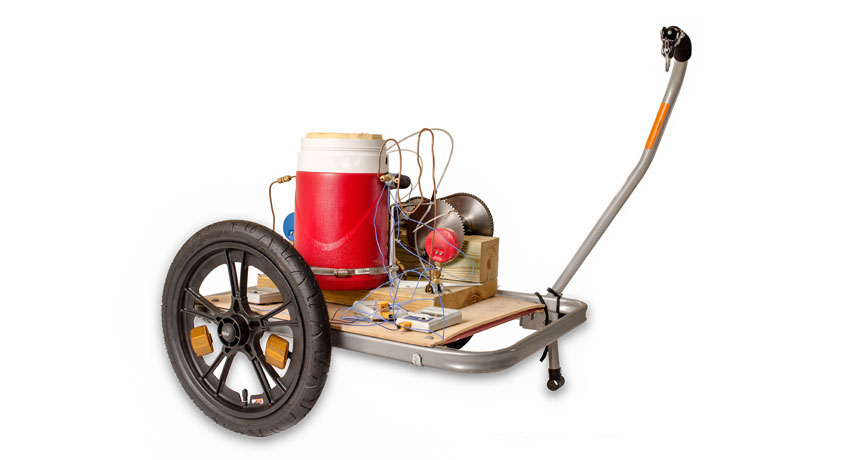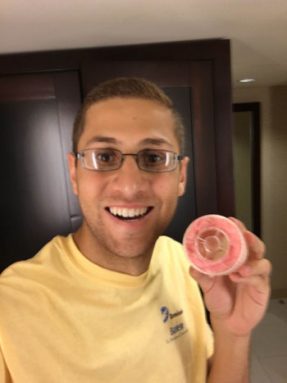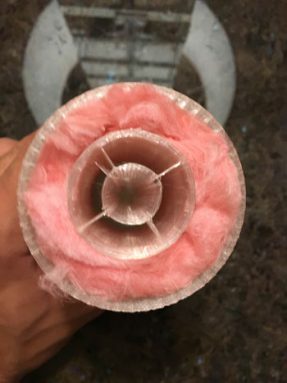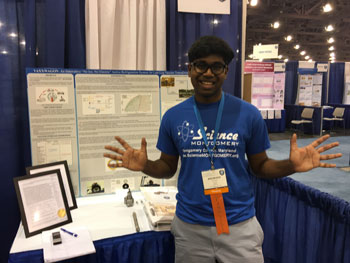Keeping samples cool without electricity
Teens invent ways to transport samples without losing their cool

This is the VAXXWAGON, a new vaccine-transport system made from a bicycle trailer.
A. Ganesan
PHOENIX, Ariz. — Doctors can face many challenges in remote areas. A big one can be a lack of refrigeration. If blood or vaccines get too warm, they can go bad. Freeze them, and the blood cells will pop or the vaccines will become inactive. So when electricity isn’t guaranteed, keeping samples at just the right temperature can be tough. Two teens have invented devices to overcome that problem. Each will keep vaccines and blood at just the right temperature. One solution is the size of a wagon. The other is only the size of a Popsicle.
Both teens presented their inventions here, this week, at the Intel International Science and Engineering Fair. Created by Society for Science & the Public and sponsored by Intel, this year’s competition brought together more than 1,600 students from more than 70 countries. (SSP also publishes Science News for Students.)
Julian Elmasry often worked in the office of his dad, a doctor. His father’s patients often had their blood drawn for tests. “Dad would put it in the refrigerator immediately,” the 18-year old recalls. A senior at Southwest Virginia Governor’s School in Pulaski, he began to wonder how that might go wrong in countries where access to refrigeration might be limited.

Cooling the blood
Julian’s system isn’t just a single test tube. It’s three, each nested inside another. The innermost test tube contains the blood sample. Between the inner and middle test tubes, are four chambers. Two hold water. The others hold ammonium thiocyanate (Ah-MOW-nee-um THY-oh-SY-uh-nayt), a toxic chemical used in photography and some fertilizers.
When the water and ammonium thiocyanate mix, they undergo an endothermic reaction — a chemical reaction that absorbs heat. In Julian’s new device, that heat will come from the blood, leaving cool blood behind. The blood’s temperature can fall from 16.9° Celsius (62° Fahrenheit) to 6.2 °C (43 °F). The large, outermost test tube contains fiberglass insulation. It can keep the inner ones cool for four to five hours.
For Julian, the road to invention didn’t always run smooth. “Last year was an utter failure,” he says. This year, he was determined to try again. He tested three different chemicals for that endothermic reaction. That’s when he learned ammonium thiocyanate worked best. He also tested three kinds of insulators and used a 3-D printer to try out different tube sizes. To test the efficiency of his device, he mixed up some fake blood — water with the right concentration of sugars, salts and a little red food coloring.

A vaccine vehicle
When Anurudh Ganesan was a baby in southern India, his parents carried him 10 miles to the nearest clinic. They wanted him to get vaccines that would make him immune to deadly diseases such as yellow fever. But arriving at the clinic, they were disappointed. The vaccines had frozen on their journey. By the time the family arrived, they were worthless.
Anurudh, now 16 and a junior at Clarksburg High School in Maryland, decided to investigate this problem. Ice packs and electricity are the most common cooling technologies used in transporting vaccines, the teen says. But these “can render vaccines useless, because they sometimes freeze them [the vaccines] so they are no longer useful,” he notes. “I thought there needs to be a solution to this problem.”
His answer is the VAXXWAGON. It is a modified bicycle trailer with a built-in refrigerator. As the wheels of the trailer roll along the ground, they power the refrigerator on the top of the trailer. This keeps the interior between 2º and 8º Celsius (or 36º to 46° Fahrenheit). The invention stays cold throughout six hours of motion. Once stopped, it keeps its cool for another four hours.
The design took a lot of testing. “Last year, I determined the feasibility of the system,” Anurudh says. “I tested that over long periods of time to see if it was cooling. And it did cool.” Phase two was the refrigeration system with wheels to make it roll. As he designed and improved the device, he measured its energy efficiency. Right now, he says, it’s around 80 percent efficient, which he hopes to improve. An even more advanced, third version is now undergoing testing to see if it can withstand higher outside temperatures.

Anarudh wanted to ensure that his design would cost no more than $100. “I really want to continue this system and try to get it out to people as soon as possible,” he says. He has filed a patent application for his invention, and continues to tinker on its design. “Right now I’m still building more systems, trying to get it as cost-effective as possible as well as more rugged.” His goal is to “put it in the field and see it save lives.”
Power Words
(for more about Power Words, click here)
ammonium thiocyanate A chemical used in photography and some fertilizers. It is very harmful if swallowed.
draft animal A “work” animal, such as an ox (cattle), horse, mule or other type of livestock. It is used to pull a cart, plow or other type of farm implement or wheeled vehicle.
endothermic A chemical reaction that absorbs energy — usually heat — from its environment.
fiberglass A material made of glass strands.
field A term to describe the real-world environment in which some research is conducted, such as at sea, in aforest, on a mountaintop or on a city street. It is the opposite of an artificial setting, such as a research laboratory.
patent A legal document that gives inventors control over how their inventions — including devices, machines, materials, processes and substances — are made, used and sold for a set period of time. Currently in the United States, this is 20 years from the date you first file for the patent. The U.S. government only grants patents to inventions shown to be unique.
Society for Science and the Public (or SSP) A nonprofit organization created in 1921 and based in Washington, D.C. Since its founding, SSP has been not only promoting public engagement in scientific research but also the public understanding of science. It created and continues to run three renowned science competitions: The Intel Science Talent Search (begun in 1942), the Intel International Science and Engineering Fair (initially launched in 1950) and Broadcom MASTERS (created in 2010). SSP also publishes award-winning journalism: in Science News (launched in 1922) and Science News for Students (created in 2003). Those magazines also host a series of blogs (including Eureka! Lab).
three-dimensional (3-D) printer A machine that takes instructions from a computer program on where to lay down successive layers of some raw material to create a three-dimensional object.
three-dimensional (3-D) printing The creation of a three-dimensional object with a machine that follows instructions from a computer program. The computer tells the printer where to lay down successive layers of some raw material, which can be plastic, metals, food or even living cells. 3-D printing is also called additive manufacturing.
vaccine A biological mixture that resembles a disease-causing agent. It is given to help the body create immunity to a particular disease. The injections used to administer most vaccines are known as vaccinations.
yellow fever A disease that creates flu-like symptoms that can start with fever, chills, headache, backache and vomiting. Roughly 15 percent of patients may go on to develop more serious disease. This can lead to uncontrolled bleeding, the failure of multiple internal organs — and death.







